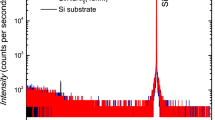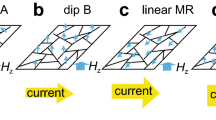Abstract
Electric-field manipulation of ferromagnetism has the potential for developing a new generation of electric devices to resolve the power consumption and variability issues in today’s microelectronics industry. Among various dilute magnetic semiconductors (DMSs), group IV elements such as Si and Ge are the ideal material candidates because of their excellent compatibility with the conventional complementary metal–oxide–semiconductor (MOS) technology. Here we report, for the first time, the successful synthesis of self-assembled dilute magnetic Mn0.05Ge0.95 quantum dots with ferromagnetic order above room temperature, and the demonstration of electric-field control of ferromagnetism in MOS ferromagnetic capacitors up to 100 K. We found that by applying electric fields to a MOS gate structure, the ferromagnetism of the channel layer can be effectively modulated through the change of hole concentration inside the quantum dots. Our results are fundamentally important in the understanding and to the realization of high-efficiency Ge-based spin field-effect transistors.
This is a preview of subscription content, access via your institution
Access options
Subscribe to this journal
Receive 12 print issues and online access
$259.00 per year
only $21.58 per issue
Buy this article
- Purchase on Springer Link
- Instant access to full article PDF
Prices may be subject to local taxes which are calculated during checkout





Similar content being viewed by others
References
Nikonov, D. & Bourianoff, G. Operation and modeling of semiconductor spintronics computing devices. J. Supercond. Novel Magn. 21, 479–493 (2008).
Wolf, S. A. et al. Spintronics: A spin-based electronics vision for the future. Science 294, 1488–1495 (2001).
Jungwirth, T., Sinova, J., Masek, J., Kucera, J. & MacDonald, A. H. Theory of ferromagnetic (III, Mn)V semiconductors. Rev. Mod. Phys. 78, 809–864 (2006).
Dietl, T., Ohno, H., Matsukura, F., Cibert, J. & Ferrand, D. Zener model description of ferromagnetism in zinc-blende magnetic semiconductors. Science 287, 1019–1022 (2000).
Akai, H. Ferromagnetism and its stability in the diluted magnetic semiconductor (In, Mn)As. Phys. Rev. Lett. 81, 3002–3005 (1998).
Matsukura, F., Ohno, H., Shen, A. & Sugawara, Y. Transport properties and origin of ferromagnetism in (Ga, Mn)As. Phys. Rev. B 57, R2037–R2040 (1998).
Yagi, M., Noba, K.-i. & Kayanuma, Y. Self-consistent theory for ferromagnetism induced by photo-excited carriers. J. Lumin. 94–95, 523–527 (2001).
Sato, K. & Katayama-Yoshida, H. First principles materials design for semiconductor spintronics. Semicond. Sci. Technol. 17, 367–376 (2002).
Ohno, H. et al. Electric-field control of ferromagnetism. Nature 408, 944–946 (2000).
Chiba, D., Matsukura, F. & Ohno, H. Electric-field control of ferromagnetism in (Ga, Mn)As. Appl. Phys. Lett. 89, 162505 (2006).
Myers, R. C. et al. Antisite effect on hole-mediated ferromagnetism in (Ga, Mn)As. Phys. Rev. B 74, 155203 (2006).
Nazmul, A. M., Kobayashi, S. & Tanaka, S. S. M. Electrical and optical control of ferromagnetism in III–V semiconductor heterostructures at high temperature (∼100 K). Jpn. J. Appl. Phys. 43, L233–L236 (2004).
Nepal, N. et al. Electric field control of room temperature ferromagnetism in III-N dilute magnetic semiconductor films. Appl. Phys. Lett. 94, 132505 (2009).
Weisheit, M. et al. Electric field-induced modification of magnetism in thin-film ferromagnets. Science 315, 349–351 (2007).
Bolduc, M. et al. Above room temperature ferromagnetism in Mn-ion implanted Si. Phys. Rev. B 71, 033302 (2005).
Park, Y. D. et al. A group-IV ferromagnetic semiconductor: MnxGe1−x . Science 295, 651–654 (2002).
Pinto, N. et al. Magnetic and electronic transport percolation in epitaxial Ge1−xMnx films. Phys. Rev. B 72, 165203 (2005).
Wang, Y. et al. Direct structural evidences of Mn11Ge8 and Mn5Ge2 clusters in Ge0.96Mn0.04 thin films. Appl. Phys. Lett. 92, 101913 (2008).
Li, A. P. et al. Magnetism in MnxGe1−x semiconductors mediated by impurity band carriers. Phys. Rev. B 72, 195205 (2005).
Knobel, R., Samarth, N., Crooker, S. A. & Awschalom, D. D. Spin-polarized quantum transport and magnetic field-dependent carrier density in magnetic two-dimensional electron gases. Phys. E: Low-dimens. Syst. Nanostruct. 6, 786–789 (2000).
Chen, J., Wang, K. L. & Galatsis, K. Electrical field control magnetic phase transition in nanostructured MnxGe1−x . Appl. Phys. Lett. 90, 012501 (2007).
Jeon, H. C. et al. (In1−xMnx)As diluted magnetic semiconductor QDs with above room temperature ferromagnetic transition. Adv. Mater. 14, 1725–1728 (2002).
Chen, Y. F. et al. Growth and magnetic properties of self-assembled (In, Mn)As QDs. J. Vac. Sci. Technol. B 23, 1376–1378 (2005).
Holub, M. et al. Mn-doped InAs self-organized diluted magnetic quantum-dot layers with Curie temperatures above 300 K. Appl. Phys. Lett. 85, 973–975 (2004).
Zheng, Y. H. et al. Cr-doped InAs self-organized diluted magnetic QDs with room-temperature ferromagnetism. Chin. Phys. Lett. 24, 2118–2121 (2007).
Stroppa, A., Picozzi, S., Continenza, A. & Freeman, A. J. Electronic structure and ferromagnetism of Mn-doped group-IV semiconductors. Phys. Rev. B 68, 155203 (2003).
Schulthess, T. C. & Butler, W. H. Electronic structure and magnetic interactions in Mn doped semiconductors. J. Appl. Phys. 89, 7021–7023 (2001).
Schilfgaarde, M. v. & Mryasov, O. N. Anomalous exchange interactions in III–V dilute magnetic semiconductors. Phys. Rev. B 63, 233205 (2001).
Ohno, H. Making nonmagnetic semiconductors ferromagnetic. Science 281, 951–956 (1998).
Kulkarni, J. S. et al. Structural and magnetic characterization of Ge0.99Mn0.01 nanowire arrays. Chem. Mater. 17, 3615–3619 (2005).
van der Meulen, M. I. et al. Single crystalline Ge1−xMnx nanowires as building blocks for nanoelectronics. Nano Lett. 9, 50–56 (2008).
Wang, M. et al. Achieving high Curie temperature in (Ga, Mn)As. Appl. Phys. Lett. 93, 132103 (2008).
Cho, Y. J. et al. Ferromagnetic Ge1−xMx (M=Mn, Fe, and Co) nanowires. Chem. Mater. 20, 4694–4702 (2008).
Dietl, T., Ohno, H. & Matsukura, F. Hole-mediated ferromagnetism in tetrahedrally coordinated semiconductors. Phys. Rev. B 63, 195205 (2001).
Kazakova, O., Kulkarni, J. S., Holmes, J. D. & Demokritov, S. O. Room-temperature ferromagnetism in Ge1−xMnx nanowires. Phys. Rev. B 72, 094415 (2005).
Liu, C., Yun, F. & Morkoç, H. Ferromagnetism of ZnO and GaN: A review. J. Mater. Sci.: Mater. Electron. 16, 555–597 (2005).
Sze, S. Physics of Semiconductor Devices 2nd edn (Wiley, 1981).
Ovchinnikov, I. V. & Wang, K. L. Voltage sensitivity of Curie temperature in ultrathin metallic films. Phys. Rev. B 80, 012405 (2009).
Maekawa, S. Concepts in Spin Electronics (Oxford Univ. Press, 2006).
Dietl, T. & Spalek, J. Effect of thermodynamic fluctuations of magnetization on the bound magnetic polaron in dilute magnetic semiconductors. Phys. Rev. B 28, 1548–1563 (1983).
Kitchen, D. et al. Hole-mediated interactions of Mn acceptors on GaAs (110) (invited). J. Appl. Phys. 101, 09G515 (2007).
Lim, S. W., Jeong, M. C., Ham, M. H. & Myoung, J. M. Hole-mediated ferromagnetic properties in Zn1−xMnxO thin films. Jpn. J. Appl. Phys. 2 43, L280–L283 (2004).
Lyu, P. & Moon, K. Ferromagnetism in diluted magnetic semiconductor quantum dot arrays embedded in semiconductors. Eur. Phys. J. B 36, 593–598 (2003).
Wang, K. L., Thomas, S. G. & Tanner, M. O. SiGe band engineering for MOS, CMOS and quantum effect devices. J. Mater. Sci.: Mater. Electron. 6, 311–324 (1995).
Wojtowicz, T. et al. Enhancement of Curie temperature in Ga1−xMnxAs/Ga1−yAlyAs ferromagnetic heterostructures by Be modulation doping. Appl. Phys. Lett. 83, 4220–4222 (2003).
Kuroda, S. et al. Origin and control of high-temperature ferromagnetism in semiconductors. Nature Mater. 6, 440–446 (2007).
Karczewski, G. et al. Ferromagnetism in (Zn, Cr)Se layers grown by molecular beam epitaxy. J. Supercond. 16, 55–58 (2003).
Jamet, M. et al. High-Curie-temperature ferromagnetism in self-organized Ge1−xMnx nanocolumns. Nature Mater. 5, 653–659 (2006).
MEDICI Two-Dimensional Semiconductor Device Simulation edited by Inc. Technology Modeling Associates, Palo Alto (2005).
Arrott, A. Criterion for ferromagnetism from observations of magnetic isotherms. Phys. Rev. 108, 1394–1396 (1957).
Acknowledgements
We gratefully acknowledge the financial support from the Western Institute of Nanoelectronics (WIN), the Intel Spin–Gain FET project and the Australian Research Council. We thank N. Dmitri of Intel Incorporation for his advice on our experiments.
Author information
Authors and Affiliations
Contributions
F.X., A.P.J. and K.L.W. conceived and designed the experiments. F.X., Y.W., J.K., A.H. and J.T. carried out the experiments. F.X., Y.W., J.Z., and K.L.W. wrote the manuscript with partial contribution from A.P.J. and J.K. All authors discussed the results and commented on the manuscript. F.X. and Y.W. contributed equally to this research.
Corresponding author
Ethics declarations
Competing interests
The authors declare no competing financial interests.
Supplementary information
Supplementary Information
Supplementary Information (PDF 902 kb)
Rights and permissions
About this article
Cite this article
Xiu, F., Wang, Y., Kim, J. et al. Electric-field-controlled ferromagnetism in high-Curie-temperature Mn0.05Ge0.95 quantum dots. Nature Mater 9, 337–344 (2010). https://doi.org/10.1038/nmat2716
Received:
Accepted:
Published:
Issue Date:
DOI: https://doi.org/10.1038/nmat2716
This article is cited by
-
Tunable rectification and magnetoresistance behaviors of ferromagnetic pn diode based on (Fe, Al)-doped SiGe with enhanced room-temperature magnetization
Science China Materials (2024)
-
Mn-doped SiGe thin films grown by UHV/CVD with room-temperature ferromagnetism and high hole mobility
Science China Materials (2022)
-
Ultrahigh-temperature ferromagnetism in MoS2 Moiré superlattice/graphene hybrid heterostructures
Nano Research (2021)
-
Fluorite-type phase of TiO2 (co)-doped with (Co, Nb and Ru): first-principles calculations
Bulletin of Materials Science (2021)
-
The dramatic enhancement of ferromagnetism and band gap in Fe-doped In2O3 nanodot arrays
Scientific Reports (2018)



